LATTICE HW-USBN-2B Programming Cables
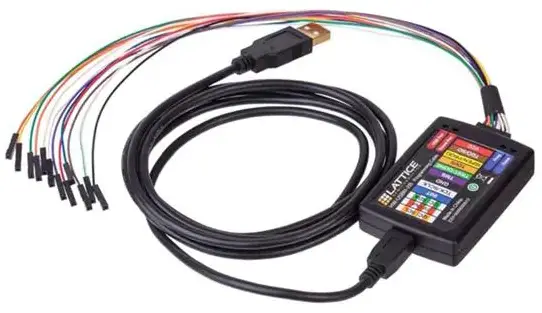
Product Information
Specifications
- Product Name: Programming Cables
- User Guide: FPGA-UG-02042-26.7
- Release Date: April 2024
Product Usage Instructions
Features
The programming cables provide essential functions for programming Lattice programmable devices. The specific functions may vary depending on the target device selected.
Programming Cables
The programming cables are designed to connect to the target device for programming purposes. They facilitate data transfer and control signals between the programming software and the programmable device.
Programming Cable Pin Definitions
The programming cable pins have specific functions that correspond to the programming features of Lattice programmable devices. Here are some key pin definitions:
- VCC TDO/SO: Programming Voltage – Test Data Output
- TDI/SI: Test Data Input – Output
- ISPEN/PROG: Enable – Output
- TRST: Test Reset – Output
- DONE: Input – DONE indicates configuration status
- TMS: Test Mode – Output
- GND: Ground – Input
- TCK/SCLK: Test Clock Input – Output
- INIT: Initialize – Input
- I2C Signals: SCL1 and SDA1 – Output
- 5 V OUT1: 5 V Output signal
*Note: Flywire connections may be required for basic JTAG programming.
Programming Cable In-System Programming Interface
The programming cable interfaces with the PC using specific pins for data transfer and control. Refer to the provided figures for detailed pin assignments.
Frequently Asked Questions
- Q: What software is recommended for programming with these cables?
- A: It is recommended to use Diamond Programmer/ispVM System software for programming with these cables.
- Q: Do I need any additional adapters for connecting the cables to my PC?
- A: Depending on your PC’s interface, you may require a parallel port adapter for proper connection.
Disclaimers
Lattice makes no warranty, representation, or guarantee regarding the accuracy of information contained in this document or the suitability of its products for any particular purpose. All information herein is provided AS IS, with all faults, and all associated risk is the responsibility entirely of the Buyer. The information provided herein is for informational purposes only and may contain technical inaccuracies or omissions, and may be otherwise rendered inaccurate for many reasons, and Lattice assumes no obligation to update or otherwise correct or revise this information. Products sold by Lattice have been subject to limited testing and it is the Buyer’s responsibility to independently determine the suitability of any products and to test and verify the same. LATTICE PRODUCTS AND SERVICES ARE NOT DESIGNED, MANUFACTURED, OR TESTED FOR USE IN LIFE OR SAFETY CRITICAL SYSTEMS, HAZARDOUS ENVIRONMENTS, OR ANY OTHER ENVIRONMENTS REQUIRING FAIL-SAFE PERFORMANCE, INCLUDING ANY APPLICATION IN WHICH THE FAILURE OF THE PRODUCT OR SERVICE COULD LEAD TO DEATH, PERSONAL INJURY, SEVERE PROPERTY DAMAGE OR ENVIRONMENTAL HARM (COLLECTIVELY, “HIGH-RISK USES”). FURTHER, BUYER MUST TAKE PRUDENT STEPS TO PROTECT AGAINST PRODUCT AND SERVICE FAILURES, INCLUDING PROVIDING APPROPRIATE REDUNDANCIES, FAIL-SAFE FEATURES, AND/OR SHUT-DOWN MECHANISMS. LATTICE EXPRESSLY DISCLAIMS ANY EXPRESS OR IMPLIED WARRANTY OF FITNESS OF THE PRODUCTS OR SERVICES FOR HIGH-RISK USES. The information provided in this document is proprietary to Lattice Semiconductor, and Lattice reserves the right to make any changes to the information in this document or to any products at any time without notice.
Features
- Support for all Lattice programmable products
- 2.5 V to 3.3 V I2C programming (HW-USBN-2B)
- 1.2 V to 3.3 V JTAG and SPI programming (HW-USBN-2B)
- 1.2 V to 5 V JTAG and SPI programming (all other cables)
- Ideal for design prototyping and debugging
- Connect to multiple PC interfaces
- USB (v.1.0, v.2.0)
- PC Parallel Port
- Easy-to-use programming connectors
- Versatile flywire, 2 x 5 (.100”) or 1 x 8 (.100”) connectors
- 6 feet (2 meters) or more of programming cable length (PC to DUT)
- Lead-free/RoHS-compliant construction
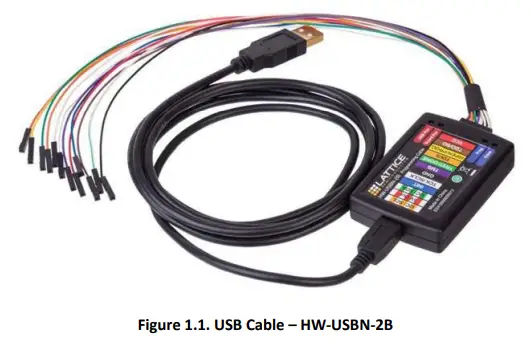
Programming Cables
Lattice Programming Cable products are the hardware connection for the in-system programming of all Lattice devices. After the user completes the logic design and creates a programming file with the Lattice Diamond®/ispLEVER® Classic/Radiant development tools, user can use Diamond/Radiant Programmer or ispVM™ System software to program devices on board. The ispVM System/Diamond/Radiant Programmer software automatically generates the appropriate programming commands, programming addresses and programming data based on information stored in the programming file and parameters set in Diamond/Radiant Programmer/ispVM System. Programming signals are then generated from the USB or parallel port of a PC and directed through the programming cable to the device. No additional components are required for programming.
Note: Port A is for JTAG programming. Radiant programming software can use the built-in cable via the USB hub on the PC, which detects the cable of the USB function on Port A. While Port B is for UART/I2C interface access.
Diamond Programmer/Radiant Programmer/ispVM System software is included with all Lattice design tool products and is available for download from the Lattice web site at www.latticesemi.com/programmer.
Programming Cable Pin Definitions
The functions provided by the programming cables correspond with available functions on Lattice programmable devices. Since some devices contain different programming features, the specific functions provided by the programming cable may depend on the selected target device. ispVM System/Diamond/Radiant Programmer software automatically generates the appropriate functions based on the selected device. See Table 3.1 for an overview of the programming cable functions.
Table 3.1. Programming Cable Pin Definitions
| Programming Cable Pin | Name | Programming Cable Pin Type | Description |
| VCC | Programming Voltage | Input | Connect to VCCIO or VCCJ plane of the target device. Typical ICC = 10 mA. The target board
provides the VCC supply/reference for the cable. |
| TDO/SO | Test Data Output | Input | Used to shift data out via the IEEE1149.1 (JTAG) programming standard. |
| TDI/SI | Test Data Input | Output | Used to shift data in via the IEEE1149.1 programming standard. |
| ISPEN/PROG | Enable | Output | Enable device to be programmed.
Also functions as SN/SSPI Chip Select for SPI programming with HW-USBN-2B. |
| TRST | Test Reset | Output | Optional IEEE 1149.1 state machine reset. |
| DONE | DONE | Input | DONE indicates status of configuration |
| TMS | Test Mode Select Input | Output | Used to control the IEEE1149.1 state machine. |
| GND | Ground | Input | Connect to ground plane of the target device |
| TCK/SCLK | Test Clock Input | Output | Used to clock the IEEE1149.1 state machine |
| INIT | Initialize | Input | Indicates device is ready for configuration to begin. INITN is only found on some devices. |
| I2C: SCL1 | I2C SCL | Output | Provides the I2C signal SCL |
| I2C: SDA1 | I2C SDA | Output | Provides the I2C signal SDA. |
| 5 V OUT1 | 5 V Out | Output | Provides a 5 V signal for the iCEprogM1050 Programmer. |
Note:
- Only found on the HW-USBN-2B cable. Nexus™ and Avant™ I2C programming ports are not supported
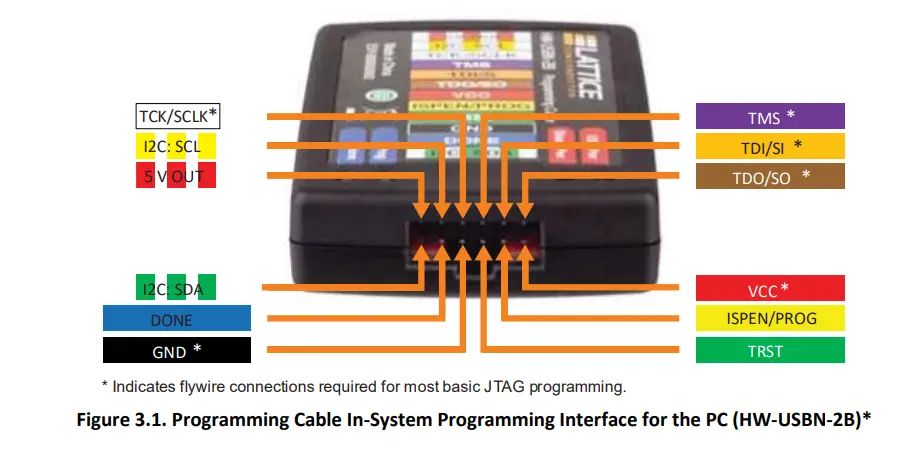

*Note: Lattice PAC-Designer® software does not support programming with USB cables. To program ispPAC devices with these cables, use the Diamond Programmer/ispVM System software.
*Note: HW7265-DL3, HW7265-DL3A, HW-DL-3B, HW-DL-3C and HW-DLN-3C are functionally equivalent products.

- Note: For reference purposes, the 2 x 10 connector on the HW7265-DL2 or HW7265-DL2A is equivalent to Tyco 102387-1. This will interface to standard 100-mil spacing 2 x 5 headers, or a 2 x 5 keyed, recessed male connector such as the 3M N2510-5002RB.
Programming Software
Diamond/Radiant Programmer and ispVM System for Classic devices is the preferred programming management software tool for all Lattice devices and download cables. The latest version of Lattice Diamond/Radiant Programmer or ispVM System software is available for download from the Lattice web site at www.latticesemi.com/programmer
Target Board Design Considerations
A 4.7 kΩ pull-down resistor is recommended on the TCK connection of the target board. This pull-down is recommended to avoid inadvertent clocking of the TAP controller induced by fast clock edges or as VCC ramps up. This pull-down is recommended for all Lattice programmable families.
The I2C signals SCL and SDA are open drains. A 2.2 kΩ pull-up resistor to VCC is required on the target board. Only VCC values of 3.3 V and 2.5 V for I2C are supported by the HW-USBN-2B cables.
For Lattice device families that feature low power, it is recommended to add a 500 Ω resistor between VCCJ and GND during the programming interval when a USB programming cable is connected to a very low power board design. A FAQ is available that discusses this in more depth at: http://www.latticesemi.com/en/Support/AnswerDatabase/2/2/0/2205
The JTAG programming port speed may need to be governed when using the programming cables connected to customer PCBs. This is especially important when there is long PCB routing or with many daisy-chained devices. The Lattice programming software can adjust the timing of TCK applied to the JTAG programming port from the cable. This low-precision port setting of TCK depends on many factors, including the PC speed and the type of cable used (parallel port, USB or USB2). This software feature provides an option to slow the TCK for debugging or noisy environments. A FAQ is available that discusses this in more depth at: http://www.latticesemi.com/en/Support/AnswerDatabase/9/7/974.aspx
The USB download cable can be used to program Power Manager or ispClock products with Lattice programming software. When using the USB cable with the Power Manager I devices, (POWR604, POWR1208, POWR1208P1), the user must slow do TCK by a factor of A FAQ is available that discusses this in more depth at: http://www.latticesemi.com/en/Support/AnswerDatabase/3/0/306.aspx
Programming Flywire and Connection Reference
Refer to Table 6.1 to identify, per Lattice device, how to connect various Lattice programming cable flywires. JTAG, SPI and I2C configuration ports are unambiguously identified. Legacy cables and hardware are included for reference. In addition, various header configurations are tabulated.
Table 6.1. Pin and Cable Reference
| HW-USBN-2B
Flywire color |
TDI/SI | TDO/SO | TMS | TCK/SCLK | ISPEN/PROG | DONE | TRST(OUTPUT) | VCC | GND | I2C: SCL | I2C: SDA | 5 V Out |
| Orange | Brown | Purple | White | Yellow | Blue | Green | Red | Black | Yellow/White | Green/White | Red/White | |
| HW-USBN-2A
Flywire color |
TDI | TDO | TMS | TCK | ispEN/PROG | INIT | TRST(OUTPUT)/DONE(INPUT) | VCC | GND |
na |
||
| Orange | Brown | Purple | White | Yellow | Blue | Green | Red | Black | ||||
| HW-DLN-3C
Flywire color |
TDI | TDO | TMS | TCK | ispEN/PROG |
na |
TRST(OUTPUT) | VCC | GND | |||
| Orange | Brown | Purple | White | Yellow | Green | Red | Black | |||||
|
Programming cable pin type Target Board Recommendation |
Output | Input | Output | Output | Output | Input | Input/Output | Input | Input | Output | Output | Output |
| — | — | 4.7 kΩ Pull-Up | 4.7 kΩ Pull-Down |
(Note 1) |
— | — |
(Note 2) |
— | (Note 3)
(Note 6) |
(Note 3)
(Note 6) |
— | |
| Connect the programming cable wires (above) to the corresponding device or header pins (below). | ||||||||||||
JTAG Port Devices
| ECP5™ | TDI | TDO | TMS | TCK |
Optional connections to device ispEN, PROGRAM, INITN, DONE and/or TRST signals (Define in Custom I/O settings in ispVM System or Diamond Programmer software. Not all devices have these pins available) |
Required | Required | — | — | — |
| LatticeECP3™/LatticeECP2M™ LatticeECP2™/LatticeECP™/ LatticeEC™ |
TDI |
TDO |
TMS |
TCK |
Required |
Required |
— |
— |
— |
|
| LatticeXP2™/LatticeXP™ | TDI | TDO | TMS | TCK | Required | Required | — | — | — | |
| LatticeSC™/LatticeSCM™ | TDI | TDO | TMS | TCK | Required | Required | — | — | — | |
| MachXO2™/MachXO3™/MachXO3D™ | TDI | TDO | TMS | TCK | Required | Required | — | — | — | |
| MachXO™ | TDI | TDO | TMS | TCK | Required | Required | — | — | — | |
| ORCA®/FPSC | TDI | TDO | TMS | TCK | Required | Required | — | — | — | |
| ispXPGA®/ispXPLD™ | TDI | TDO | TMS | TCK | Required | Required | — | — | — | |
| ispMACH® 4000/ispMACH/ispLSI® 5000 | TDI | TDO | TMS | TCK | Required | Required | — | — | — | |
| MACH®4A | TDI | TDO | TMS | TCK | Required | Required | — | — | — | |
| ispGDX2™ | TDI | TDO | TMS | TCK | Required | Required | — | — | — | |
| ispPAC®/ispClock™ (Note 4) | TDI | TDO | TMS | TCK | Required | Required | — | — | — | |
| Platform Manager™/Power Manager/ Power Manager II/Platform Manager II (Note 4) | TDI |
TDO |
TMS |
TCK |
Required |
Required |
— |
— |
— |
|
CrossLink™-NX/Certus™-NX/ CertusPro™-NX/Mach™-NX/MachXO5™-NX |
TDI |
TDO |
TMS |
TCK |
Optional connections to device ispEN, PROGRAMN,
INITN, DONE and/or TRST signals (Define in Custom I/O settings in ispVM System or Diamond Programmer software. Not all devices have these pins available) |
Required |
Required |
— |
— |
— |
||
| HW-USBN-2B
Flywire color |
TDI/SI | TDO/SO | TMS | TCK/SCLK | ISPEN/PROG | DONE | TRST(OUTPUT) | VCC | GND | I2C: SCL | I2C: SDA | 5 V Out |
| Orange | Brown | Purple | White | Yellow | Blue | Green | Red | Black | Yellow/White | Green/White | Red/White | |
| HW-USBN-2A
Flywire color |
TDI | TDO | TMS | TCK | ispEN/PROG | INIT | TRST(OUTPUT)/DONE(INPUT) | VCC | GND |
na |
||
| Orange | Brown | Purple | White | Yellow | Blue | Green | Red | Black | ||||
| HW-DLN-3C
Flywire color |
TDI | TDO | TMS | TCK | ispEN/PROG |
na |
TRST(OUTPUT) | VCC | GND | |||
| Orange | Brown | Purple | White | Yellow | Green | Red | Black | |||||
|
Programming cable pin type Target Board Recommendation |
Output | Input | Output | Output | Output | Input | Input/Output | Input | Input | Output | Output | Output |
|
— |
— |
4.7 kΩ
Pull-Up |
4.7 kΩ Pull-Down |
(Note 1) |
— |
— |
(Note 2) |
— |
(Note 3)
(Note 6) |
(Note 3)
(Note 6) |
— |
|
| Connect the programming cable wires (above) to the corresponding device or header pins (below). | ||||||||||||
Slave SPI Port Devices
| ECP5 | MOSI | MISO | — | CCLK | SN |
Optional connections to device PROGRAMN, INITN and/or DONE signals |
Required | Required | — | — | — | |
| LatticeECP3 | MOSI | MISO | — | CCLK | SN | Required | Required | — | — | — | ||
| MachXO2/MachXO3/MachXO3D | SI | SO | — | CCLK | SN | Required | Required | — | — | — | ||
|
CrossLink LIF-MD6000 |
MOSI |
MISO |
— |
SPI_SCK |
SPI_SS |
Opt. CDONE |
CRESET_B |
Required |
Required |
— |
— |
— |
| iCE40™/iCE40LM/iCE40 Ultra™/ iCE40 UltraLite™ |
SPI_SI |
SPI_SO |
— |
SPI_SCK |
SPI_SS_B |
Opt. CDONE |
CRESET_B |
Required |
Required |
— |
— |
— |
|
CrossLink-NX/Certus-NX/CertusPro-NX |
SI |
SO |
— |
SCLK |
SCSN |
Opt.Opt DONE | — |
Required |
Required |
— |
— |
— |
I2C Port Devices
| I2C Port Devices | ||||||||||||
| MachXO2/MachXO3/MachXO3D | — | — | — | — |
Optional connections to device PROGRAMN, INITN and/or DONE signals |
Required | Required | SCL | SDA | — | ||
| Platform Manager II | — | — | — | — | Required | Required | SCL_M + SCL_S | SDA_M + SDA_S | — | |||
| L-ASC10 | — | — | — | — | — | — | — | Required | Required | SCL | SDA | — |
|
CrossLink LIF-MD6000 |
— |
— |
— |
— |
— |
Opt. CDONE |
CRESET_B |
Required |
Required |
SCL |
SDA |
— |
Headers
| 1 x 10 conn (various cables) | 3 | 2 | 6 | 8 | 4 | 9 or 10 | 5 or 9 | 1 | 7 | — | — | — |
| 1 x 8 conn | 3 | 2 | 6 | 8 | 4 | — | 5 | 1 | 7 | — | — | — |
| 2 x 5 conn | 5 | 7 | 3 | 1 | 10 | — | 9 | 6 | 2, 4,or 8 | — | — | — |
Programmers
| Model 300 | 5 | 7 | 3 | 1 | 10 | — | 9 | 6 | 2, 4,or 8 | — | — | — |
| iCEprog™ iCEprogM1050 | 8 | 5 | — | 7 | 9 | 3 | 1 | 6 | 10 | — | — | 4 (Note 5) |
Notes:
- For older Lattice ISP devices, a 0.01 μF decoupling capacitor is required on ispEN/ENABLE of the target board.
- For HW-USBN-2A/2B, the target board supplies the power – Typical ICC = 10 mA. For devices that have a VCCJ pin, the VCCJ must be connected to the cable’s VCC. For other devices, connect the appropriate bank VCCIO to the cable’s VCC. A 0.1 μF decoupling capacitor is required on VCCJ or VCCIO close to the device. Please refer to the device data sheet to determine if the device has a VCCJ pin or what VCCIO bank governs the target programming port (this may not be the same as a target device’s core VCC/VSS plane).
- Open drain signals. Target board should have ~2.2 kΩ pull-up resistor connected to the same plane to which VCC is connected. HW-USBN-2B cables provide internal 3.3 kΩ pull-ups to VCC.
- When using PAC-Designer® software to program ispPAC or ispClock devices, do not connect TRST/DONE.
- If using a cable older than HW-USBN-2B, connect a +5 V external supply between iCEprogM1050 pin 4 (VCC) and pin 2 (GND).
- For HW-USBN-2B, only VCC values of 3.3 V thru 2.5 V are supported for I2C.
Connecting the Programming Cable
The target board must be unpowered when connecting, disconnecting, or reconnecting the programming cable. Always connect the programming cable’s GND pin (black wire) before connecting any other JTAG pins. Failure to follow these procedures can result in damage to the target programmable device.
Programming Cable TRST Pin
Connecting the board TRST pin to the cable TRST pin is not recommended. Instead, connect the board TRST pin to Vcc. If the board TRST pin is connected to the cable TRST pin, instruct ispVM/Diamond/Radiant Programmer to drive the TRST pin high.
To configure ispVM/Diamond/Radiant Programmer to drive TRST pin high:
- Select the Options menu item.
- Select Cable and I/O Port Setup.
- Select the TRST/Reset Pin-Connected checkbox.
- Select the Set High radio button.
If the proper option is not selected, the TRST pin is driven low by ispVM/Diamond/Radiant Programmer. Consequently, the BSCAN chain does not work because the chain is locked into RESET state.
Programming Cable ispEN Pin
The following pins should be grounded:
- BSCAN pin of the 2000VE devices
- ENABLE pin of MACH4A3/5-128/64, MACH4A3/5-64/64 and MACH4A3/5-256/128 devices.
However, user have the option of having the BSCAN and ENABLE pins driven by the ispEN pin from the cable. In this case, ispVM/Diamond/Radiant Programmer must be configured to drive the ispEN pin low as follows:
To configure ispVM/Diamond/Radiant Programmer to drive ispEN pin low:
- Select the Options menu item.
- Select Cable and I/O Port Setup.
- Select the ispEN/BSCAN Pin-Connected checkbox.
- Select the Set Low radio button.
Each programming cable ships with two small connectors that help to keep the flywires organized. The following manufacturer and part number is one possible source for equivalent connectors:
- 1 x 8 Connector (for example, Samtec SSQ-108-02-T-S)
- 2 x 5 Connector (for example, Samtec SSQ-105-02-T-D)
The programming cable flywire or headers are intended to connect to standard 100-mil spacing headers (pins spaced 0.100 inch apart). Lattice recommends a header with length of 0.243 inches or 6.17 mm. Though, headers of other lengths may work equally well.
Ordering Information
Table 10.1. Programming Cable Feature Summary
| Feature | HW-USBN-2B | HW-USBN-2A | HW-USB-2A | HW-USB-1A | HW-DLN-3C | HW7265-DL3, HW7265-DL3A, HW-DL-3B,
HW-DL-3C |
HW7265-DL2 | HW7265-DL2A | PDS4102-DL2 | PDS4102-DL2A |
| USB | X | X | X | X | — | — | — | — | — | — |
| PC-Parallel | — | — | — | — | X | X | X | X | X | X |
| 1.2 V Support | X | X | X | — | — | — | — | — | — | — |
| 1.8 V Support | X | X | X | X | X | X | — | X | — | X |
| 2.5-3.3 V
Support |
X | X | X | X | X | X | X | X | X | X |
| 5.0 V Support | — | X | X | X | X | X | X | X | X | X |
| 2 x 5 Connector | — | X | X | X | X | X | X | X | — | — |
| 1 x 8 Connector | X | X | X | X | X | — | — | X | X | |
| Flywire | X | X | X | X | X | X | — | — | — | — |
| Lead-free Construction | X | X | — | — | X | — | — | — | — | — |
| Available for order | X | — | — | — | X | — | — | — | — | — |
Table 10.2. Ordering Information
| Description | Ordering Part Number | China RoHS Environment- Friendly Use Period (EFUP) |
| Programming cable (USB). Contains 6′ USB cable, flywire connectors, 8-position (1 x 8) adapter and 10-position (2 x 5) adapter, lead-free, RoHS compliant construction. | HW-USBN-2B | 
|
| Programming cable (PC only). Contains parallel port adapter, 6′ cable, flywire connectors, 8-position (1 x 8) adapter and 10- position (2 x 5) adapter, lead-free, RoHS compliant construction. | HW-DLN-3C |
Note: Additional cables are described in this document for legacy purposes only, these cables are no longer produced. The cables currently available for order are fully equivalent replacement items.
Appendix A. Troubleshooting the USB Driver Installation
It is essential that user install the drivers before connecting user PC to the USB cable. If the cable is connected before installing the drivers, Windows will try to install its own drivers that may not work. If user have attempted to connect the PC to the USB cable without first installing the appropriate drivers, or have trouble communicating with the Lattice USB cable after installing the drivers, follow the steps below:
- Plug in the Lattice USB cable. Choose Start > Settings > Control Panel > System.
- In the System Properties dialog box, click the Hardware tab and Device Manager button. Under Universal Serial
Bus controllers, user should see Lattice USB ISP Programmer. If user do not see this, look for the Unknown Device with the yellow flag. Double click on the Unknown Device icon.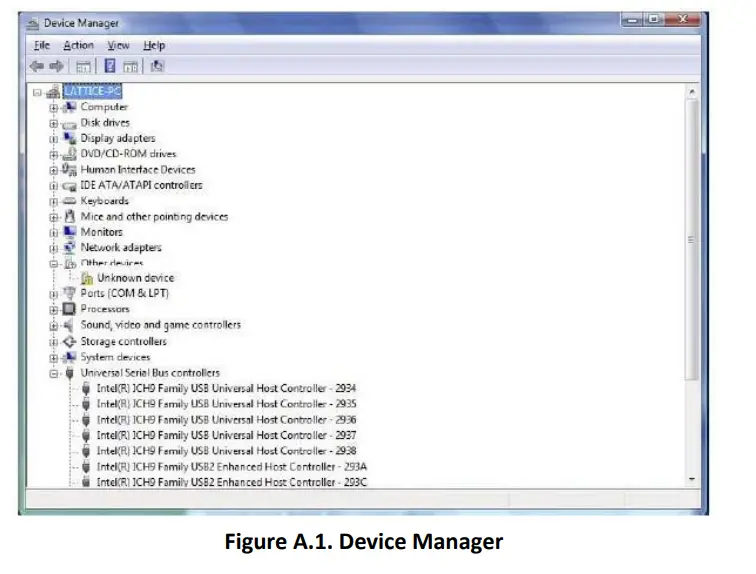
- In the Unknown device Properties dialog box, click Reinstall Driver.
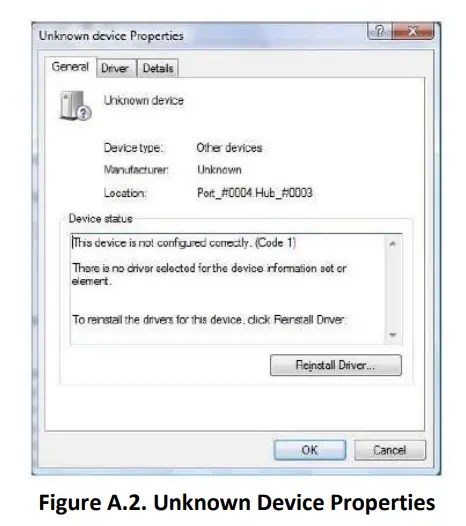
- Select Browse my computer for driver software.
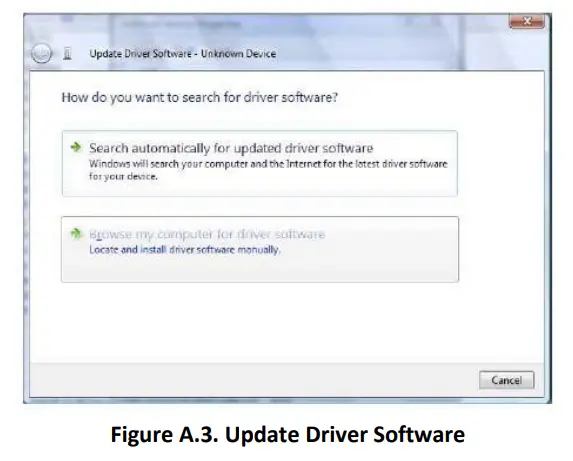
- Browse to the isptools\ispvmsystem directory for the Lattice EzUSB driver
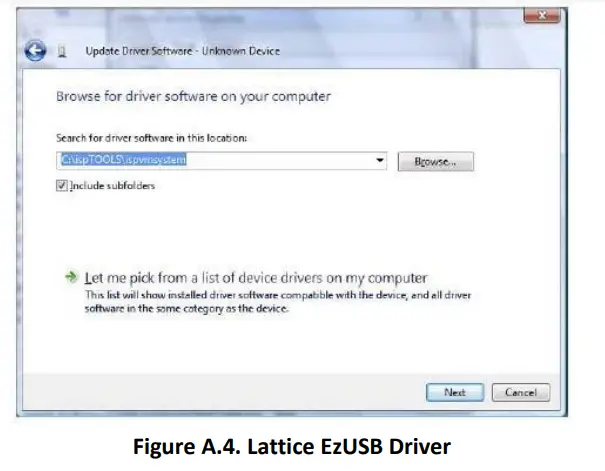
- Browse to the isptools\ispvmsystem\Drivers\FTDIUSBDriver directory for the FTDI FTUSB driver.
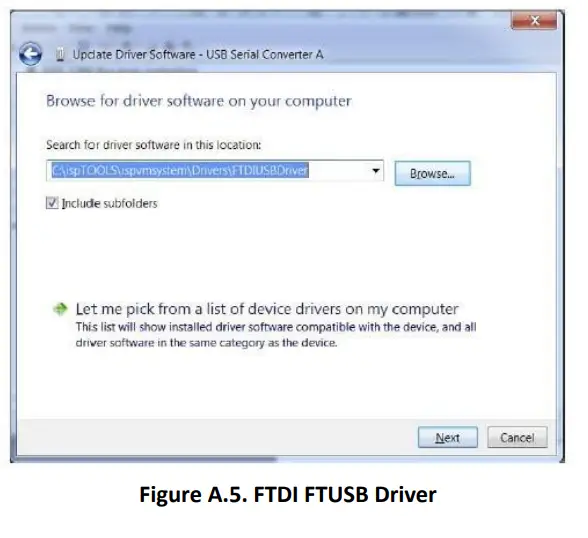
- For Diamond installations, browse to lscc/diamond/data/vmdata/drivers. Click Next.
- Select Install this Driver software anyway. The system updates the driver.
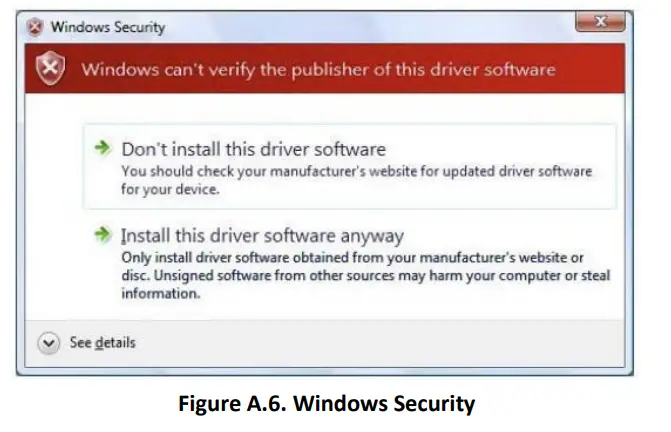
- Click Close and finish installing the USB driver.
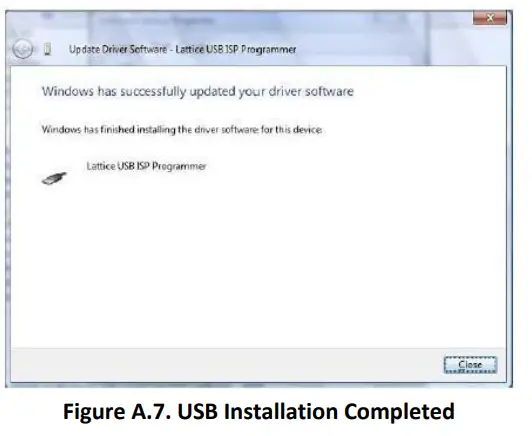
- Under Control Panel >System >Device Manager > Universal Serial Bus Controllers should include the following:
a. For the Lattice EzUSB Driver: Lattice USB ISP Programmer device installed. b. For the FTDI FTUSB Driver: USB Serial Converter A and Converter B devices installed.
b. For the FTDI FTUSB Driver: USB Serial Converter A and Converter B devices installed.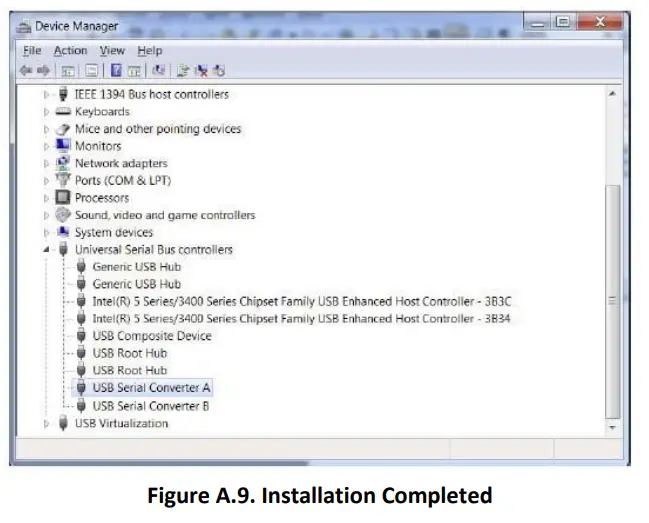
If the user experiencing problems or needs additional information, contact Lattice Technical Support.
Appendix B. USB Programming Cable Firmware Update
There is a known issue where cable firmware with version V001 may cause the USB programming cable to malfunction with the LEDs light always on in certain scenarios. The workaround is to update the cable firmware and FTDI firmware version to V002 to resolve this issue. Please download and install the HW-USBN-2B Firmware version 2.0 or later, available from our website. The firmware and update instruction guide, is available from our website
Technical Support Assistance
For assistance, submit a technical support case at www.latticesemi.com/techsupport.
For frequently asked questions, refer to the Lattice Answer Database at www.latticesemi.com/Support/AnswerDatabase.
Revision History
Revision 26.7, April 2024
| Section | Change Summary |
| Programming Cable Pin Definitions | Updated note 1 to Table 3.1. Programming Cable Pin Definitions to indicate that Nexus and Avant I2C programming ports are not supported. |
| Programming Flywire and Connection Reference | Table 6.1. Pin and Cable Reference:
· Grouped Nexus product lines into a single row for JTAG and SSPI ports. · Added MachXO5-NX to the JTAG port devices list. · Removed Nexus product lines for I2C port. |
Revision 26.6, November 2023
| Section | Change Summary |
| Disclaimers | Updated this section. |
| Appendix A. Troubleshooting the USB Driver Installation | Added sentence There is a known issue where cable firmware with version “V001” may cause the USB programming cable to malfunction with LEDs light always on in certain scenario.
The workaround is to update the cable firmware and FTDI firmware version to “V002” to resolve this issue. Please download and install the HW-USBN-2B Firmware version 2.0 or later, available from our website. |
| Appendix B. USB Programming Cable Firmware Update | Added this section. |
Revision 26.5, March 2023
| Section | Change Summary |
| Programming Flywire and Connection Reference | Added Crosslink-NX, Certus-NX, CertusPro-NX and Mach-NX to the JTAG, SPI and I2C Port Devices list in Table 6.1. Pin and Cable Reference. |
| Programming Cables | Added note information for Port A and Port B “Port A is for JTAG programming. Radiant programming software can use the built-in cable via the USB hub on the PC, which detects the cable of the USB function on Port A. While Port B is for UART/I2C interface access.”. |
| All | Added Radiant reference. |
| Technical Support | Added FAQ website link. |
Revision 26.4, May 2020
| Section | Change Summary |
| Programming Cables | Updated Lattice website link to www.latticesemi.com/programmer |
| Programming Software |
Revision 26.3, October 2019
| Section | Change Summary |
| Target Board Design Considerations;
Programming Flywire and Connection Reference |
Clarified VCC values that I2C interface supports. Added notes to Table 6.1. |
Revision 26.2, May 2019
| Section | Change Summary |
| — | Added Disclaimers section. |
| Programming Flywire and Connection Reference | Updated Table 6.1. Pin and Cable Reference.
· Added MachXO3D · Added CRESET_B to Crosslink I2C. · Updated items under I2C Port Devices · Added Platform Manager II. · Changed order of ispPAC. · Updated items under I2C Port Devices. · Changed Power Manager II to Platform Manager II and updated I2C: SDA value. · Changed ASC to L-ASC10 · Updated footnote 4 to include ispClock devices. · Adjusted trademarks. |
| Revision History | Updated format. |
| Back cover | Updated template. |
| — | Minor editorial changes |
Revision 26.1, May 2018
| Section | Change Summary |
| All | Corrected entries in the Slave SPI Port Devices section of Table 6.1. |
Revision 26.0, April 2018
| Section | Change Summary |
| All | · Changed document number from UG48 to FPGA-UG-02024.
· Updated document template. |
| Programming Cables | Removed redundant information and changed the link to www/latticesemi.com/software. |
| Programming Cable Pin Definitions | Updated Programming Cable Pin names in Table 3.1. Programming Cable Pin Definitions. |
| Programming Flywire and Connection Reference | Replaced Table 2. Flywire Conversion Reference and Table 3 Recommended Pin Connections with a single Table 6.1 Pin and Cable Reference. |
| Ordering Information | Moved Table 10.1. Programming Cable Feature Summary under Ordering Information. |
Revision 25.0, November 2016
| Section | Change Summary |
| Programming Flywire and Connection Reference | Revised Table 3, Recommended Pin Connections. Added CrossLink device. |
Revision 24.9, October 2015
| Section | Change Summary |
| Programming Flywire and Connection Reference | Revised Table 3, Recommended Pin Connections.
· Added CRESET-B column. · Added iCE40 UltraLite device. |
| Technical Support Assistance | Updated Technical Support Assistance information. |
Revision 24.8, March 2015
| Section | Change Summary |
| Programming Cable Pin Definitions | Revised description of INIT in Table 1, Programming Cable Pin Definitions. |
Revision 24.7, January 2015
| Section | Change Summary |
| Programming Cable Pin Definitions | · In Table 1, Programming Cable Pin Definitions, ispEN/Enable/PROG changed to ispEN/Enable/PROG/SN and its description revised.
· Updated Figure 2, Programming Cable In-System Programming Interface for the PC (HW-USBN-2B). |
| Programming Cable ispEN Pin | In Table 4, Programming Cable Feature Summary, HW-USBN-2B marked as available for order. |
| Ordering Information | HW-USBN-2A changed to HW- USBN-2B. |
Revision 24.6, July 2014
| Section | Change Summary |
| All | Changed document title from ispDOWNLOAD Cables to Programming Cables User’s Guide. |
| Programming Cable Pin Definitions | Updated Table 3, Recommended Pin Connections. Added ECP5, iCE40LM, iCE40 Ultra, and MachXO3 device families. |
| Target Board Design Considerations | Updated section. Updated FAQ link on ispVM tool control of TCK duty cycle and/or frequency. |
| Technical Support Assistance | Updated Technical Support Assistance information. |
Revision 24.5, October 2012
| Section | Change Summary |
| Programming Flywire and Connection Reference | Added iCE40 configuration port pin names to the Flywire Conversion Reference table. |
| Programming Flywire and Connection Reference | Added iCE40 information to the Recommended Cable Connections table. |
Revision 24.4, February 2012
| Section | Change Summary |
| All | Updated document with new corporate logo. |
Revision 24.3, November 2011
| Section | Change Summary |
| All | Document transferred to user’s guide format. |
| Features | Added Figure USB Cable – HW-USBN-2A. |
| Programming Flywire and Connection Reference | Updated Recommended Cable Connections table for MachXO2 devices. |
| Target Board Design Considerations | Updated section. |
| Appendix A | Added section. |
Revision 24.2, October 2009
| Section | Change Summary |
| All | Added information related to the physical specifications of the flywire connectors. |
Revision 24.1, July 2009
| Section | Change Summary |
| All | Added Target Board Design Considerations text section. |
| Programming Flywire and Connection Reference | Added section heading. |
Previous Revisions
| Section | Change Summary |
| — | Previous Lattice releases. |
2024 Lattice Semiconductor Corp. All Lattice trademarks, registered trademarks, patents, and disclaimers are as listed at www.latticesemi.com/legal. All other brand or product names are trademarks or registered trademarks of their respective holders. The specifications and information herein are subject to change without notice
Downloaded from Arrow.com
Documents / Resources
 |
LATTICE HW-USBN-2B Programming Cables [pdf] User Guide HW-USBN-2B Programming Cables, HW-USBN-2B, Programming Cables, Cables |




